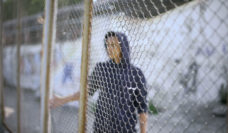The asylum-seekers I work with recount the persecution, torture, and terrors that led them to flee their homes, as well as the traumas that occurred during their journeys. They tell me — sometimes with tears, with sighs, in whispers, with knitted brows, after long pauses — of how they came to decide the only homes they’d ever known were no longer safe. They recall and relive the peril they endured as they fled across deserts, mountains, rivers, oceans, and through unwelcoming cities and camps. They have experienced the worst of what humans do to one another and their resilience is remarkable.
Unfortunately, trauma does not end once a migrant reaches a border and requests asylum. For an estimated 4,000 children who sought safety and freedom in the United States, new experiences of loss and violation occurred in the care of the United States, where they were separated from their families at the behest of federal policy. Even after the policy’s official end in 2018, government-imposed family separation continued for at least a year and a half, separating over 1,100 children, of which 300 were under the age of 5.
Government-imposed family separation has prompted prominent medical and psychological organizations, including the American Medical Association and American Psychiatric Association, to decry the anticipated impacts of this separation on children, families, and communities. Much is known about the behavioral, emotional, neurobiological, physiologic, generational, and societal effects of disrupted attachment broadly and in other specific scenarios, however, little effort has been made to synthesize the impacts of 21st century, government-imposed separation of migrant families. My co-author Dr. Shawn Singh Sidhu and I examined the medical literature for evidence documenting the mental health impacts of separating migrant children from their families. Our findings were recently published in the Journal of the American Academy of Child and Adolescent Psychiatry.
The data we identified paint grim pictures, unsurprising in their general thrust and disturbing in granular detail. High levels of psychiatric symptomatology were identified among children separated at the southern border of the United States, including frequent worrying, crying, appetite suppression, insomnia, nightmares, depressed moods, panic, hopelessness, and despair. Children demonstrated attachment difficulties ranging from disorganized and aggressive behavior with staff to excessive clinginess when reunified with parents. They also displayed developmental regression in the forms of thumb sucking, bedwetting, and an inability to sleep independently. The majority of adults and children in this sample met diagnostic criteria for at least one of the following: post-traumatic stress disorder, major depressive disorder, or generalized anxiety disorder.
Particularly concerning is that these difficulties continued after reunification, and that short-term separation appeared to be as impactful as long-term separation.
In another sample, children suffered emotional problems, peer problems, and general behavioral problems , while younger children demonstrated significantly higher rates of hyperactivity and behavioral problems. Particularly concerning is that these difficulties continued after reunification, and that short-term separation appeared to be as impactful as long-term separation.
While the data we examined elucidated the nature of immediate mental health effects, we do not yet know the long-term impacts on the emotional development of these children. Family separation broadly is considered an adverse childhood event (ACE) and ACEs are known to be associated with negative effects on mental and physical health, as well as quality of life and functioning throughout the lifespan. How government-imposed family separation of migrants differs from family separation generally over time remains to be seen.
Migrant children and families who suffered involuntary separation, whether they remain in the United States or continue on to seek safety elsewhere, ought to be the subject of close clinical attention to determine their unique mental health needs. These children and their families may require a tailored mix of psychological, social, and community resources to best support their healing and rehabilitation.
The data suggest that, when migrant families are reunited after separation, they are more easily able to resettle and reintegrate into their new communities. Policies that facilitate reunification after migration can be reparative for the children and families who suffered separation. Meanwhile, policies that actively prevent separation offer hope to the tortured and persecuted across the globe as they contemplate ways to protect their families. Such preventative policies ensure that a family fleeing danger may assert their rights to seek asylum, without the threat that governments will separate their family, thereby jeopardizing their family’s mental health.
Photo via Getty Images














